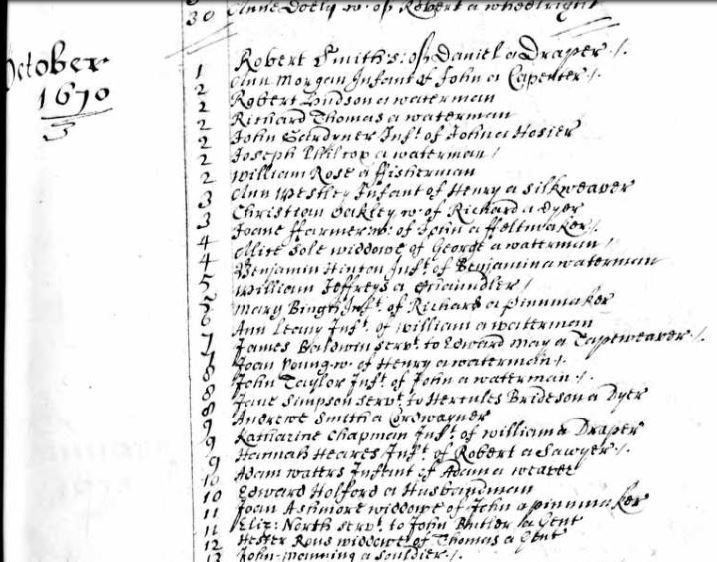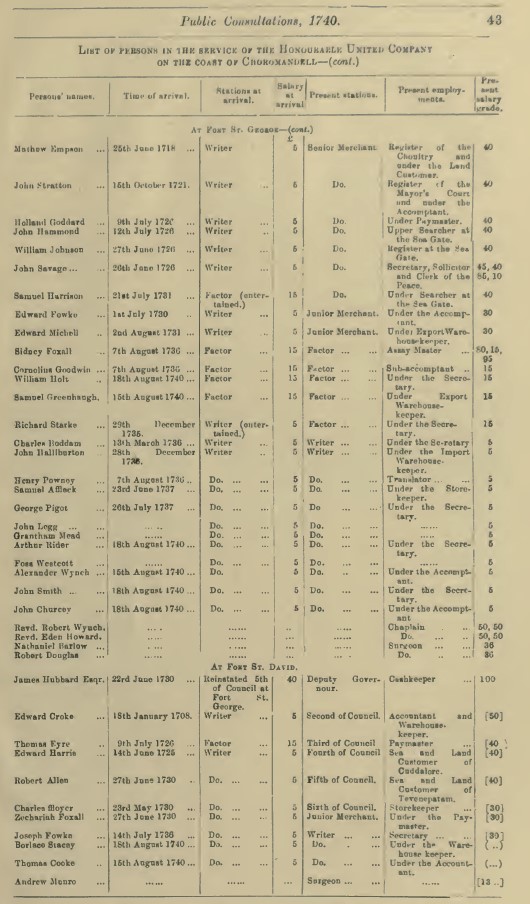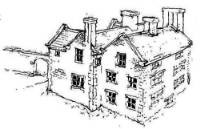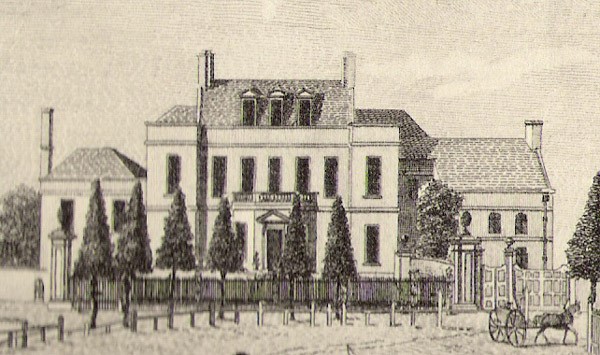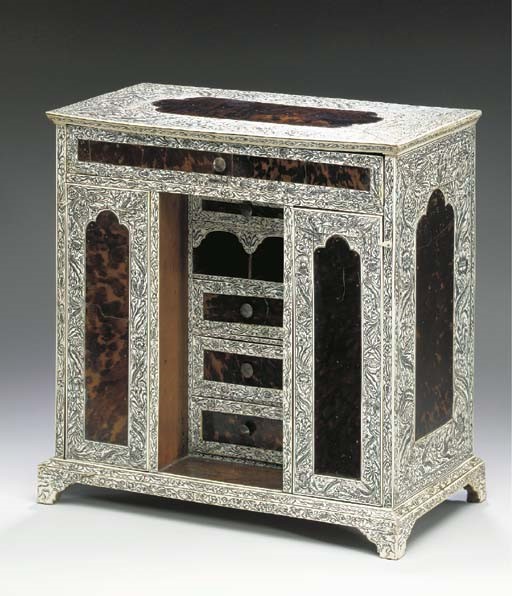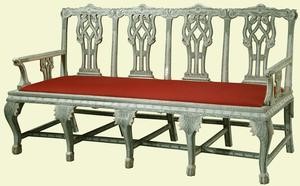Sir John Frederick, Lord Mayor of London
Curiously, William Rous (211 211 211 21), in his will, asks to be buried:
“near the vault belonging to the family of Sir John Frederick under the monument of Sir Nathaniel Herne deceased on the South side of the Parish Church of St Olave Old Jury London”
Nathaniel Herne’s inscription (on the South Wall) noted:
HERE LYETH IN HOPES OF A GLORIOUS
RESURRECTION THE BODY OF SR NATHANIEL
HERNE, KNIGHT, LATE SHERIFFE, AND AT HIS DEATH
ALDERMAN OF THIS FAMOUS CITTY AND GOVERNOR
OF THE HONOURABLE EAST INDIA COMPANY, SON
TO NICHOLAS AND GRANDSON TO RICHARD HERNE
SOMETIMES ALDERMAN ALLSO OF THIS CITTY A
PERSON OF GREAT PRUDENCE AND INDEFATIGABLE
INDUSTRY IN THE MANNER OF ALL PUBLICK
AFFAIRS OF EXEMPLARY PIETY, SPOTLESS INTEGRITY
AND DIFFUSIVE CHARITY HAVEING WITH HIS OWNE
HAND DISPENCED VERY CONSIDERABLE SUMMES TO
MANY CHARITABLE USES PARTICULARLY TO THE RELEIFE
OF POORE SEAMEN & EDUCATING OF THEIR CHILDREN.
HE TOOKE TO WIFE JUDITH ELDEST DAUGHTER OF SR
JOHN FREDERICK, KNIGHT, ALDERMAN AND SOMETIMES
LORD MAYOR OF LONDON, HIS NOW SORROWFULL
WIDDOW BY WHOME HE HAD DIVERS CHILDREN
AND LEFT THREE HOPEFULL SONS SURVIVING VIZ.
FREDERICK, NATHANIEL AND THOMAS TO WHOSE
& TO THIS CITTYES & NATIONS GREAT LOSS AS ALLSO
TO YE GREIFE OF ALL THEM THAT KNEW HIM HE
DEPARTED THIS LIFE YE 16TH AUGUST 1679 AETAT 50.
There is no reference to the family vault, nor even of Sir John Frederick in the catalogue of Monumental Inscriptions[1] but in the Parish registers for St Olave’s Jewry there is reference to the burials of Sir John Frederick on 19th March 1684/5 (will[2] proved 4th May 1685) and of his widow, Dame Mary Frederick on 19th October 1689.
Sir John Frederick was the fourth son of Christopher Frederick of London, Surgeon to King James I, who died in October 1623. Sir John married (16th January 1636/7 at St Helen Bishopsgate) Mary Rous, the daughter of Thomas Rous of London, Merchant of Lime Street, London by his wife. Examination of the ancestry of Mary Rous might, therefore, reasonably be expected to shed light on the ancestors of William Rous (211 211 211 21).
Dame Mary Frederick (née Ruys or Rous)
Examination of the records of Austin Friars shows the marriage on 21st April 1617 of Thomas Ruijs and Judith Moenen of Norwich (the daughter of Martin Moenen).

Extract from Parish Registers of the Dutch Congregation of Austin Friars, London
The will of Martin Moenen, Merchant, from Great Yarmouth (dated 9th March 16278 and proved seven weeks later on 28th April 1628) refers to his wife, Marie, his three sons, John, Abraham and Nathaniell (A), and his three daughters, Sara (B), Judith (C) and Abigail (D). He also refers to his “Son in Law Thomas Russe”. His reference to his Brother in Law Angell Hollwicke Leonardson may suggest his wife might have been Marie Leonardson – but there is no evidence to support this and he may have been a brother-in-law by way of the marriage of his sister or even a step brother by way of a remarriage of his mother.
“The Dutch at Yarmouth had a chapel for their use, which had originally been the mansion of Thomas de Drayton, a bailiff and a representative of the town, temp. Edw. III. Whether they converted it into a chapel or not, does not appear; it was afterwards used as a theatre… but by an order of the King in 1632, it was … termed a chapel, and was theretofore used by the Dutch for their assembling and divine service…within less than forty years it was a warehouse, and it was ordered that it should therefore be used no longer for the celebration of divine service”[3]
The name ‘Moenen’ seems to have become anglicised as ‘Moone’ within the first generation from Martin Moenen.
A John Moone, Merchant was noted in the Parliamentary Papers in 1642:[4]
“Ordered, That the Ten Chests of Glasses, belonging to John Moone of London, Merchant, imported from Venice, and seized aboard the Ship, by Sir Robert Mansfeild, by virtue of his Patent, shall be forthwith delivered to Mr. Moone, he paying the King’s Duties and Customs for the same. And it is further Ordered, That all such other Merchants as have their Glasses seized by Sir Robert Mansfeild, by virtue of his Patent shall have the same delivered unto them. And Sir Robert Mansfeild is to attend this House forthwith; and to bring his Patents with him; and to shew unto this House, by what Authority he hath seized the Merchants Glasses.”
It is not known if this is the same John Moenen.
Abraham Moone[5] (son of Abraham Moone, and grandson of Martin Moone/Moenen) was listed as being in the Parish of Bishopsgate Within between 1675-79 and in Great St Helens in London in 1677; he was born in 1638 and was buried at St Helens Bishopsgate on 4th June 1688 having married in 1663 Anne Daniel (daughter of Thomas Daniel of St Michael Wood Street).
Nathaniell Moone (A), Citizen and Merchant tailor of London refers, in his will (dated 26th April 1637 and proved 2nd September 1637), to both Thomas Ruys the Elder and Thomas Ruys the Younger (Thomas Ruys Senior was Executor with Abraham Cullen). Nathaniell also refers to his brother John Moone, his sister Sara Moone and his Partner John Frederick. The will was witnessed by Adam Lawrence.

Index of Wills of the Prerogative Court of Canterbury (1637)
 Burial Register, St Olave, Old Jewry, London (1637)
Burial Register, St Olave, Old Jewry, London (1637)
Nathaniel Moone (A) married Elizabeth whose will was dated 14th October 1640, with a codicil of the same date and proved 9th November 1640. In it she refers to her late husband Nathaniell Moone; her uncle Adam Lawrence and his wife; John Frederick; her husband’s brother John Moone and his three children; Judith Ruis, widow, her late husband’s sister; the eight children of Sara Puits her late husband’s sister whose legacies are to be “paid to Richard Lawrence their brother in law”; Abigaill, wife of Abraham Keullen her late husband’s sister. In a codicil she itemises possessions as particular bequests, including:
“to my sister Ruys I give my wedding ring with the diamond in it, and to my said sister Anne (sic.) daughters, cousin Mary Frederick and cousin Judith Ente, all my chaine, the turkey carpet, the three best wrought cushions to be equally divided amonge them two; and to my cousin Anne Ruys the gould wrought purse with all the same money that is therein.”
Sara Moene (B) married James de Puydt or Payt (who predeceased her) and, in her will of 13th November 1638 (written in Dutch and proved 7th December 1638), she refers to her eight living children: James, Thomas, Mary, Sara, Ann, Priscilla, Judith and Abigail – she also refers to her Son in Law Richard Lawrence. The will was witnessed by Abraham Moone (her brother) and Thomas Ruys.
 Index of Wills of the Prerogative Court of Canterbury (1638)
Index of Wills of the Prerogative Court of Canterbury (1638)
Judith Moenen (C) married at the Dutch Church of Austin Friars on 29th April 1617 to Thomas Ruijs of Gorchum (Gorinchem near Dordrecht in Holland – the Netherlands).

Extract from Parish Registers of the Dutch Congregation of Austin Friars, London
Abigail Moenen (D) married Abraham Van Cuelen (or Van Galulen):
Abraham Van Cuelen changed his name to Cullen and it was this Abraham Cullen and Thomas Rous whos obtained a Patent in 1626 for the manufacture of stone jugs, pots and bottles.[6] Individual consignments of stoneware to the alien merchants in London in the period 1600-1640 were often very large; it was noted that in May 1633 Thomas Rous received one consignment of 10,000 cast, valued at £125.[7]
Abraham Cullen the Elder of London, Merchant, died in 1658 (his will was dated 16th January 16578 and was proved 7th September 1658). He refers in his will to his family (including to his late wife Abigaell who is buried in St Hellens Parish Church in Bishopsgate, London. Unfortunately for these present purposes, he makes no mention of Thomas Ruys the Younger, nor any reference to William Rous which would help to tie these loose ends together.
The records of Mortlake Church[8] show:
“Esther, daughter of Sr Abraham Cullen and Abigail, baptized Sep. 28, 1665;
Sr Abraham Cullen, buried Sep. 2, 1668.”
Sir Abraham Cullen was the son of Abraham Cullen and Abigail Moenen (D).
Thomas Ruijs or Ruys etc.
Thomas Ruijs (or, variously, Russe, Rowse, Ruys or Rous) from Gorchum (or Gorinchem in the Netherlands) was buried on 3rd September 1640, and his will (written in Dutch 17th April 1640 and translated at the time, proved 10th September 1640) refers to his wife, Judith Ruys, and five living children: Thomas (a), Abraham (b) and Anne (c) (all under twenty-one years of age and at least Anne being unmarried) and his daughters Mary (d) and Judith (e) (both of whom, by implication, are married and have received their marriage portions). He also leaves a bequest to his Niece Anne de Puydt if she has not reached twenty-one years of age or married before his death. He also refers to Adam Lawrence as his Uncle. Thomas Ruys also refers in his will to his Son in Law John Frederick.

Extract from Parish Registers of St Dionis Backchurch, London

Index of Wills of the Prerogative Court of Canterbury (1640)
The registers of Austin Friars also show the baptisms of three of Thomas’s children:

Extract from Parish Registers of the Dutch Congregation of Austin Friars, London
Thomas Rouse (senior) was shown as living in Lime Street in the Ward of St Dionis Backchurch in 1638,[9] in a property with rental value of thirty pounds per year.
Thomas Ruys senior’s will ties in with his daughter being the same Mary Rous (d) who married John Frederick, and further research supports this.
“These families combined with their great wealth a certain foregnness, which continued from generation to generation, as did their financial and trading interests. The pre-Revocation Huguenots did not perhaps feel themselves part of a great community of their fellow-countrymen and co-religionists, but of a smaller one of protestant foreigners who had settled in England and prospered. Both Flemish and French, they intermarried also with the Dutch community, as in the match in 1662 of Sir John [Frederick], later Sheriff of London, whose son married Leonora Maresco, to the daughter of the merchant Thomas Rouse (Ruys), a member of the Dutch Church, Austin Friars.”
Proceedings of the Huguenot Society of London VOL. XXIII, NO.6
(the original reference to Sir John Lethieullier is a mistake and should read Sir John Frederick)
Mary Rous (d) or Dame Mary Frederick as she became, died in 1689 and was buried on 19th December 1689 at St Olave’s, Old Jewry, London:

She had a number of children with Sir John Frederick, of whom some did not survive to adulthood:
Her children were:
- John Frederick (chr. 1st January 16378, St Olave, Old Jewry, London;

bur. 24th May 1638, St Olave, Old Jewry); 
- Judith Frederick (chr. 7th August 1639, St Olave, Old Jewry, London),

who became Dame Judith Herne, wife of Sir Nathaniell Herne as shown in the Marriage Register of St Olave, Old Jewry, London of 1656:
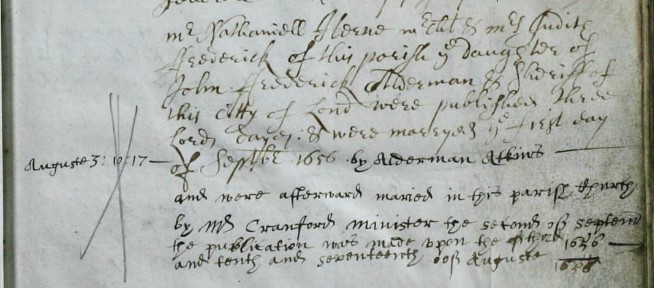
- Mary Frederick (chr. 3rd October 1641, St Olave, Old Jewry, London,

bur. 21st January 16456, St Olave, Old Jewry, London)

- Robert Frederick (b. 8th August 1646, chr. 17th August 1646, St Olave, Old Jewry, London,

bur. 25th December 1651, St Olave, Old Jewry, London)

- Mary Frederick (b. 16th April 1648, chr. 26th April 1648, St Olave, Old Jewry, London);

bur. 8th January 16567, St Olave, Old Jewry, London)

- Thomas Frederick (b. 7th July 1650, chr. 11th July 1650, St Olave, Old Jewry, London)

- Anne Frederick (b. 16th September 1651; chr. 25th September 1651, St Olave, Old Jewry, London)

- John Frederick (bur. 30th March 1652, St Olave, Old Jewry, London)

- John Frederick (chr. 9th December 1652, St Olave, Old Jewry, London)

bur. 6th May 1653, St Olave, Old Jewry, London)

- Elizabeth Frederick (chr. 31st October 1655, St Olave, Old Jewry, London)

- Mary Frederick (chr. 29th March 1657, St Olave, Old Jewry, London,

bur. 11th June 1658, St Olave, Old Jewry, London)

- Rebecca Frederick (chr. 6th November 1658, St Olave, Old Jewry, London)

who married Francis Godsprit (or Gosfight or Gosfrith) on 22nd December 1689 at St Olave, Old Jewry, London)

- Sarah Frederick (bur. 28th July 1662, St Olave, Old Jewry, London)

Mary’s older surviving son, Thomas Frederick (who lived at Downing Street in Westminster), was baptised in 1650. He had issue including Sir John Frederick 1st Bt, and Sir Thomas Frederick Kt. Thomas Frederick died in June 1720.
The National Archives summarises the background to this branch of the Frederick family:[10]
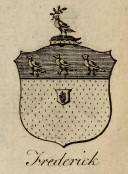
“Christopher Frederick, founder of the family, came to England from Hainault during the reign of Elizabeth I, and enjoyed the queen’s patronage. He became a member of the Worshipful Company of Barber-Surgeons in 1595 and was appointed Sergeant-Surgeon to James I. The family settled in the City of London, in the parish of St Olave, Old Jewry, where they acquired considerable property.
The earliest member of the family for whom records survive in this accession is Christopher’s fourth son, John (1601-1685), who was Lord Mayor of London, 1661-1662. He was knighted in 1660. His son, Thomas (1650-1720), followed the family tradition of marrying an heiress, Leonara Maresco, in 1676. They had five children: two sons, John and Thomas (1680-1731), and three daughters, the youngest of whom, Jane, became Duchess of Atholl by her second marriage. Thomas’s marriage was stormy and, after a series of lawsuits over the Maresco property, he and his wife separated in 1715 (see 183/28/6).
The elder son, John, was created a baronet in 1723. His two sons succeeded him in turn, John in 1755, and Thomas in 1757. When the latter died in 1770 without leaving a son, the title passed to his cousin John Frederick of Burwood, who became 4th baronet.
Thomas Frederick, the younger son of Thomas (1650-1720), served in the East India Company and became governor of Fort St David and Fort St George, Madras, where he married in 1705, and where most of his children were born. He was a director of the South Sea Company and was knighted in 1721. The City of London properties were left to him by his father, who also left large legacies to his sons. Thomas used his legacy to acquire the Burwood estate at Walton on Thames. His three eldest sons, Thomas, John (later 4th baronet) and Charles, and three daughters, Mary, Henrietta and Hannah, appear in these records. Mary married Alexander Hume, MP, and Hannah his brother Abraham, who was created a baronet in 1769. Henrietta married Luke Spence of South Malling, Sussex (see 183/22/1-17). The younger Thomas Frederick (1707-1740) was MP for Shoreham-by-Sea, West Sussex, until his death, when his brother John took over the seat. He relinquished it to his younger brother, Charles, in 1746, and became MP for West Looe in Cornwall.
Charles Frederick was MP for Shoreham, 1746-1754, and then for Queenborough, Kent, until 1784. He entered the Office of Ordnance and was Comptroller in 1749 at the time of the celebrations of the Peace of Aix-la-Chapelle, being responsible for the ill-fated firework display. In 1761 he was created a Knight of the Bath. In 1746 he married the Hon Lucy Boscawen, a daughter of Viscount Falmouth. They had three sons, Charles, Thomas Lenox and Edward Boscawen Frederick, and two daughters, Augusta, who married Thomas Prescott, and Lucy who married Crispe Molineux.”
(my emphasis and footnotes)
Kimber & Johnson[11] note, under 321. FREDERICK, of Westminster:
“Created BARONET, June 10, 1723.
This family is descended from Sir John Frederick, Knt. (son of Christopher Frederick, citizen of London) lord-mayor of the city of London, 1662, who was one of the most considerable traders in the said city. He was a worthy benefactor to christ’s Hospital, and left issue Thomas Frederick, of Downing street, Westminster, Esq; who had three sons,
- Sir John Frederick, Bart, of whom hereafter;
- Sir Thomas Frederick, Knt. who went to the Indies, acquired a considerable fortune, and there married; and left issue, Thomas Frederick, Esq; member of parliament for Shoreham, in Sussex, who died in 1740; John Frederick, of Burwood, in Walton upon Thames, in Surry, Esq; who succeeded his brother in estate, and as member for Shoreham, and married a daughter of Sir Roger Hudson, Bart. Sir Charles who has served in several parliaments for Queenborough, in Kent, in 1746, he was appointed clerk of deliveries in the office of Ordinances; in 1750 was made surveyor of the Ordnance, and assistant to the master-general of the Ordnance; in March 1761, he was elected Knight Companion of the noble order of the bath, and installed May 26 following. He married Lucy, daughter to the Right Hon. Hugh Boscawen, Viscount Falmouth, and has issue. The other children of Sir Thomas were, Marisco, who is a colonel on half pay; and four daughters, of which the eldest married Alexander Hume, Esq. Lady Frederick, surviving Sir Thomas, was remarried to William Pointz, Esq; receiver-general of the excise.
- Charles Frederick, Esq; who died unmarried; also three daughters, Mary, the eldest, married Thomas Powell, of Nanteos in Cardiganshire, Esq; Leonora, (deceased) who married Rumney Diggle, of Grays-Inn, Esq; and Jane, who married, first, James Lannoy, of hammersmith, in Middlesex, Esq; and since, his grace the Duke of Athol.
Sir John Frederick, Bart, the eldest son, was advanced to this dignity in the ninth year of King George I. He married, in July 1727, one of the daughters of __ Kinnersley, Esq; by whom he left two sons, Sir John, his successor, and Sir Thomas, the present Baronet. His lady died Aug. 31, 1749, and Sir John in Oct. 1755. He was succeeded by his eldest son, Sir John Frederick, who died unmarried, March 24, 1757, and was succeeded by his only brother.
Sir Thomas Frederick, the present baronet, who married Elizabeth, daughter of Pater Bathurst, of Clarendon Park, in Wiltshire, Esq; by which lady, who died Sept 11, 1764, he has two daughters.
ARMS: Ot, on a Chief, Azure, three Doves, Argent.
CREST: On a Cap of Dignity, Azure, turned up Ermine, a Dove, as in the Arms, holding in his Beak and Olive-Branch, proper.
SEAT: At Hampton, in Middlesex.”
Judith Ruys (e), who was baptised 26th March 1622 at the Dutch Church of Austin Friars, the daughter of Thomas Ruijs and Judith Moenen (C), married firstly, 21st August 1638 at St Dionis Backchurch, London, to Peter Ent of St. Lawrence Jewry, London and of Sandwich in Kent. Peter Ent was a Clothworker and Citizen of London. His brother was Sir George Ent kt. (born 6th November 1604, died 13th October 1689, recorded in various volumes as the son of Josias Ent (sometimes called John Ent), a Belgian immigrant. The Heraldry of Foreigners in England 1400-1700 (Harleian Society) notes that Josias Ent, a Dutchman probably married Judith, the daughter of Francis Beake (or Beke) of Norwich, whose ancestors came out of Flanders. Judith Ruys and Peter Ent had a son and two daughters, who died young. The second daughter, Judith was baptised 11th December 1642 at St Olave Old Jewry, London, and was buried on 20th July 1655 at St Christopher-le-Stocks. Peter Ent’s will was dated 16th June 1644 and was proved 3rd September 1644, in which he refers to his Mother in Law Judith Ruys (C).
 Register of St Olave, Old Jewry, London (1639)
Register of St Olave, Old Jewry, London (1639)
 Burial Register of St Olave, Old Jewry, London (1640/41)
Burial Register of St Olave, Old Jewry, London (1640/41)
 Register of St Olave, Old Jewry, London (1640)
Register of St Olave, Old Jewry, London (1640)
 Register of St Olave, Old Jewry, London (1642)
Register of St Olave, Old Jewry, London (1642)
Judith Ruys or Rous (e) married secondly on 22nd February 16523 to John Adrian, a Merchant of London who was born circa 1603. John Adrian’s first wife, Hester de la Tombe had died in September or October1652 (she was buried on 7th October 1652) by whom he had three surviving infant children, and, at the time of his second marriage, Judith’s infant daughter was still alive. John Adrian was assessed in 1662 with 11 hearths at Broad Street in St Christopher’s Precinct in the City of London. John Adrian died at Caen in France on 5th October 1669 and in his will (dated 6th November 1667, proved 22nd October 1669) he refers to “Judith Rouse my wife’s mother”.
 Register of St Christopher-le-Stocks, London (1669)
Register of St Christopher-le-Stocks, London (1669)
Judith Adrian died in 16867 and was buried on 6th January that year at St Christopher-le-Stocks.
 Register of St Christopher-le-Stocks, London (1687/88)
Register of St Christopher-le-Stocks, London (1687/88)
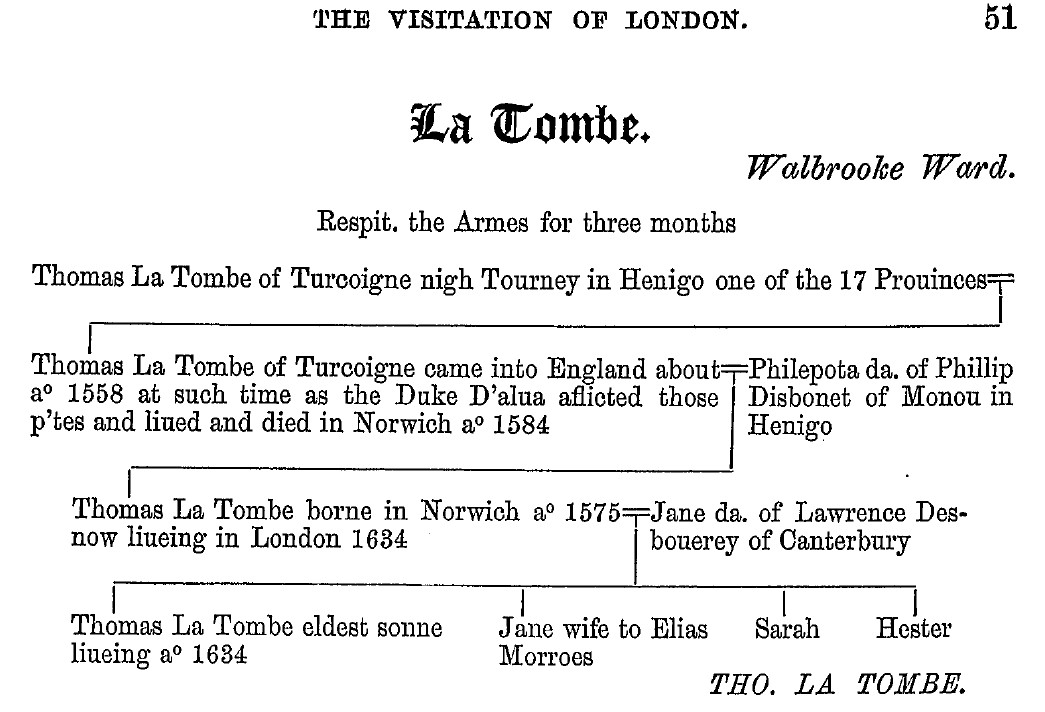 Visitation of London 1634 (Hester la Tombe, first wife of John Adrian)
Visitation of London 1634 (Hester la Tombe, first wife of John Adrian)
Thomas Adrian was born on 28th December 1653
 Register of St Christopher-le-Stocks, London (1653)
Register of St Christopher-le-Stocks, London (1653)
Thomas Adrian married Anne Crispe 16th November 1675 at St Sepulchre, Holborn by licence[12]:
“11 Nov 1675 Thomas Adrian, of St Sepulchre’s, Lond., Bachr, abt 22, & Anne Crispe, of the same, Spr, abt 22, with her brother’s consent; alleged by Thomas Rock, of Doctors’ Commons, Lond., Gent.; at St Peter’s the Poore or St Christopher’s the Stocks, Lond.”
 Register of St Sepulchre, Holborn, Middlesex (1675)
Register of St Sepulchre, Holborn, Middlesex (1675)
Thomas Adrian’s will, dated and proved in 1701 refers to his late mother Judith Adrian but gives no further clues to unlocking William Rous’s identity.
Judith Adrian was born 21st January 16556
 Register of St Christopher-le-Stocks, London (1655/56)
Register of St Christopher-le-Stocks, London (1655/56)
Judith married Sir Nicholas Crispe 30th April 1674 at St Mary, Islington, by licence dated 20th April 1674:[13]
“Crispe, Sir Nicholas, of the Middle Temple, bart., bachelor, about 30, and Mrs Judith Adrian, of St Dunstan-in-the-West, spinster, about 20, her mother’s consent – at, St. Pancras, Middlesex. 20 April, 1674. V.”
 Register of St Mary, Islington, Middlesex (1674)
Register of St Mary, Islington, Middlesex (1674)
Judith Crispe, daughter of Sir Nicholas Crispe, died in 1700: [14]
“27 Jul 1700 Mrs Judith Crispe d. of ye late Sr Nicholas, Patron of ys Church, was Buried in yr own Vault”
Anne Rous (c) married John Niclaes, a Merchant who was engaged in trade with India for the Honourable East India Company (for example the following excerpt from 1662: [15]
“That the undermentioned persons are to take place in order as they are underwritten in each place, vidiz :
Fort St. George. Sir Edward Winter, Knt. and Bart., Mr. William Gifford, Shem Bridges, James Noell, Nathaniel Budlie, Thomas Stiles, Robert dearinge, William Dawes, Edward Harris, Thomas Haslewood, Stephen Charlton, John Grover, John ffeild, Isack Jones, John Hopkins.
Metchlepatam. Mr. William Jearsie [and five others].
Mettapollum. Mr John Niclaes [and two others].
Pettepolie. Ambrose Saulsbury [and another].
To go downe into the bay. Mr. William Blake [and three others].
(Fac. Rec. F. St. G., vol i., 20th Oct., 1662.)
The volume: “The English factories in India, 1618-1669: a calendar of documents in the India Office, British Museum and Public Record Office” indicates that John Niclaes first went to India in 1662. Niclaes was injured in fighting on the Coromandel Coast in 1663. In 1664 Niclaes was summoned to Madras which he resisted. Niclaes was arrested and imprisoned and, in due course in 1664 ordered back to England. In 1668 in the Court Rolls of January 15, Niclaes was ordered back to Madras.[16]
In the Prerogative Court of Canterbury the will of John Niclaes’s father was proved in 1649 – apparently before John Niclaes married Anne Rous (c).

Anne Rous (c) and John Niclaes (or Nicholas) had, according to Dame Mary Frederick’s will, three daughters:
Judith Niclaes who married first William Edwards and had a daughter Anne Edwards– referred to in Dame Mary Frederick’s will as “my Cousin Anne Edwards, spinster, Daughter of William Edwards, late Citizen and Apothecary of London, deceased”:
“20 Mar 1670-1 William Edwards, of St Matthew’s, Friday Street, Lond., Apothecary, Widr, abt 40, & Mrs Judith Niclaes, of Wandsworth, Surry, Spr, abt 22, with consent of her mother; at St Alphage, Lond.”[17]
Judith married secondly to Valentine Sparrow on 23rd April 1685 at St Botolph, Aldgate:
 Register of St Botolph, Aldgate (1685)
Register of St Botolph, Aldgate (1685)
Judith may be the same Judith Sparrow, widow who was buried at St Giles Cripplegate on 13th June 1720 (Valentine Sparrow’s will was proved in 1703, leaving behind his widow, Judith; his two sons, Valentine and Edward; and his daughter, Judith):
 Register of St Giles, Cripplegate (1720)
Register of St Giles, Cripplegate (1720)
Anne Niclaes married Thomas Willie on 26th December 1682 at St Olave, Old Jewry, London by licence:
“22 Dec 1682 Thomas Willie, of St Bottolph’s, Aldersgate, Lond., Mariner, Bachr, abt 30, & Mrs Anne Nicleas, of St Olave’s Jury, Lond., Spr, abt 24, at her own disp.; at St Olave’s or St Lawrence, Old Jewry, Lond.”[18]
 Register of St Olave, Old Jewry, London (1682)
Register of St Olave, Old Jewry, London (1682)
Mary Niclaes whose married name was Price.
Going back to the children of Thomas Ruijs (or, variously, Russe, Rowse, Ruys or Rous) from Gorchum and his wife, Judith Ruys née Moenen (C); from the records of St Dionis Backchurch, London, we can see the baptism on 18th February 16267 of twin boys Abraham (b) and Jacob Rowse born to Thomas Rouse.
 Extract from Parish Registers of St Dionis Backchurch, London (1626/27)
Extract from Parish Registers of St Dionis Backchurch, London (1626/27)
Jacob did not survive more than a few days and was buried at St Dionis.
No clear evidence has been discovered yet to identify what became of Abraham Rouse (b), although in 1664 an Abraham Rous was assessed for Hearth Tax at Codpis Courte in the Ward of St Margaret Westminster (he had three hearths).
Abraham le Roux, Merchant of London (will of 1652) refers to several of the same names from the Dutch Congregation as cousins – including John Adrian, the second husband of Judith Ruys (e), daughter of Thomas Ruys and Judith Ruys (née Moenen (C)). He does not, however, seem to be the same Abraham Ruys.
Adam Lawrence (sometimes also referred to as Abraham Lawrence), referred to in Thomas Ruys’s will as his Uncle, refers to Judith Rowse (C) in his will of 1656:
“I give to my kinswoman Judith Rowse widow the sum of twenty five pounds to buy her a piece of plate in remembrannce of me provided that she shall makeseal and deliver her act and deed unto my executor a full release and discharge of all legacies gifts and bequests whatsoever given to her by the last will and testament of my late loving wife and of all claims and demands or other pretences whatsoever for or concerning the same, I having in my lifetime given unto each of the daughters of my said cousin Judith Rowse the sum of two hundred pounds apiece for and towards their preferment in marriage; otherwise this legacy to be void.”
Judith Rouse (Rowse or Ruys, née Moenen) (C) refers in her will (dated 10th October 1667 and proved 27th April 1670) to five children, namely her daughters Anne Niclaes (c) (wife of John Niclaes), Dame Mary Frederick (d) (wife of Sir John Frederick) and Judith Adrian (e) (wife of John Adrian), and her sons Thomas Rowse (a) (and his wife Anne) and Abraham (b). She also refers to her Grandson Nathaniel Herne and his wife Judith, and other named grandchildren: Thomas Frederick, Elizabeth Frederick, Rebeckah Frederick; Thomas Adrian, Judith Adrian, Mary Adrian; Judith Niclaes, Anne Niclaes, Mary Niclaes; Anne Rowse, Judith Rowse and Elizabeth Rowse. There is still no reference to William Rous, but it seems that not all grandchildren are listed. The will suggests there were children of Thomas and Anne and that there may have been children of Abraham, although no reference is made to Abraham having (had) a wife. The will divides Judith’s estate into twenty parts of which five parts to Thomas Rowse, five parts to Anne Niclaes, three and a half parts to Abraham Rowse with six and a half parts remaining between Judith Adrian, Mary Frederick and her Grandson Nathaniel Herne.

From bequests register accessed through www.londonlives.org (April 13th 2013)
No record has yet been found of the baptism of Thomas Ruys or Rouse Junior (a). Boyd’s Inhabitants of London suggests that Thomas Rouse junior married Anne Nicholas, daughter of John Nicholas at Holy Trinity Minories in 1647. The extract from the Marriage Register of Holy Trinity Minories (below) – written in the margin of the register – suggest that Thomas Rowse (a) married his cousin Ann Niclaes on 4th November 1647, and Boyd notes that Thomas Rouse was a Merchant and was also His Majesty’s Agent in Tunis. The Boyd entry (ref 29516) suggests Thomas Rouse junior had six children: John (1651), Anne, Judith, Elizabeth, Abigail and Mary. Again, no sign of William Rous (211 211 211 21).
 Marriage Register of Holy Trinity Minories (1647)
Marriage Register of Holy Trinity Minories (1647)
The marriage of Thomas Rowse and Ann Niclaes in 1647 was too late for them to be the parents of William Rous (211 211 211 21), given that he was apprenticed in 1657. Perhaps (assuming this was the same Thomas Rowse (a)) he had married before and/or had William before he was married to Ann.
There was a Thomas Rowse who was admitted to the Freedom of the East India Company on 27th March 1650, and who subsequently transferred five hundred pounds in United Joint Stock to John Frederick.
“Thomas Rowse [and others] admitted to the freedom [of the East India Company] on payment of 5L each and 10s to the poor box.” [19]
And then again on 28th May 1652:
“Thomas Rowse transfers to John Fredericke 500/. adventure and profits in the United Joint Stock, all of which is paid in.” [20]
There is a further reference to a Thomas Rouse on 28th April 1675:
“Thomas Rouse to be paid 5I. for transcribing the Ledger and Journal of Surat Factory No. L” [21]
And on 2nd June 1675:
“The accounts of John Niclaes and Charles Smeaton to be examined and reported.”
And on 20th September 1675:
(Court Book, vol. xxix, P. 314)
“Dr. William Aglionby is admitted to the freedom by redemption. A report touching the account of the late John Niclaes is read certifying that he is debited 200L for 500 pagodas for his debt to Sir Thomas Chamber which debt Sir Thomas in the late award assigned to the Company, the bond being in Mr. Jerzey’s hands, which the executrix of Niclaes alleges is satisfied by his inventory amounting to 593 pagodas, which sum came to Jerzey’s hands.”
And, finally, on 10th November 1675
(Court Book, vol. xxix, P- 371)
“A report touching the account of the late John Niclaes is read and approved, and order given for the sum of 194L. 6s. 8d. due on the said account to be paid to those authorized to receive it.”
Summary of Descendants of Martin Moenen
From the above analysis we can deduce the following:
1. Martin Moenen (d. 1628) of Great Yarmouth
sp. Marie; they had issue:
. a. John Moenen (alias Moone) who had issue including
. i. Judith Moone
. b. Abraham Moenen (alias Moone) who had issue including
. i. Mary Moone
. c. Nathaniell Moenen (A) (alias Moone) Citizen and Merchant Tailor of London
(d. 1637; bur. Sep 1 1637, St. Olave Old Jewry, London
. sp. Elizabeth (d. 1640); they had no issue
. d. Sara Moene (B) (d. 1638)
. sp1. __ Lawrence; they had issue
. i. Richard Lawrence
. sp2. James de Puydt (d. bef. 1638); they had issue
. i. James de Puydt
. ii. Thomas de Puydt
. iii. Mary de Puydt
. iv. Sara de Puydt
. v. Ann de Puydt
. vi. Priscilla de Puydt
. vii. Judith de Puydt
. viii. Abigail de Puydt
. e. Judith Moenen ( C) (bur. Nov 12 1669, St Dionis Backchurch, London)
. m. Apr 21 1617 (Austin Friars, London)
. sp. Thomas Ruijs of London but from Gorinchem, Netherlands, Merchant
. they had issue
. i. Thomas Ruys (Rous) (a)
. sp. Ann Niclaes; they had issue
. ii. Mary Ruys (Rous) (d) (bap. Mar 8 1617/18, Austin Friars, London)
. m. Jan 10 1636/37 (St. Hellen, Bishopsgate, London)
. sp. Sir John Frederick (d. Aug 16 1679); they had issue
. 1. John Frederick (b. 1637; d. 1638)
. 2. Judith Frederick (b. 1639)
. sp. Sir Nathaniell Herne
. 3. Mary Frederick (b. 1641; d. 1645/6)
. 4. Robert Frederick (b. 1646; d. 1651)
. 5. Mary Frederick (b. 1648; d. 1656/7)
. 6. Thomas Frederick (b. Jul 7 1650; bap. Jul 11 1650)
. m. 1676
. sp. Leonora Maresco; they had issue two sons and three daughters
. 7. Anne Frederick (b. 1651)
. 8. John Frederick (d. 1652)
. 9. John Frederick (b. 1652; d. 1653)
. 10. Elizabeth Frederick (b. 1655)
. sp. Joseph Herne
. 11. Mary Frederick (b. 1657; d. 1658)
. 12. Rebecca Frederick (b. 1658)
. m. 1689
. sp. Francis Gosfright
. 13. Sarah Frederick (d. 1662)
. iii. Judith Ruys (Rous) (bap. Mar 26 1622, Austin Friars, London)
. m1 Aug 21 1638
. sp1. Peter Ent; they had issue
. 1. Thomas Ent (b. 1639; d. 1640)
. 2. Judith Ent (b. 1640; d. 1641/42)
. 3. Judith Ent (b. 1642; d. 1655)
. m2 Feb 22 1652/3
. sp. John Adrian; they had issue
. 1. Thomas Adrian (b. 1653)
. 2. Judith Adrian (b. 1655/6)
. 3. Mary Adrian
. iv. Abraham Ruys
. v. Jacob Ruys
. vi. Anne Ruys (c)
. sp. John Niclaes, Merchant
. f. Abigail Moenen (D)
. sp. Abraham van Cuelen or Galulen (changed his name to Cullen)
. they had issue including
. i. Sir Abraham Cullen
In the will of Dame Mary Frederick[22] – Mary Rous (d) – far from unravelling any mystery of William Rous’s forebears, Mary refers only to ‘my Sister Anne Rouse’ – whom I take to be the wife or widow of Thomas Rous (a) – and to her sister Anne Nicholas (c) and her surviving children.
What is not clear, therefore, is how William Rous (211 211 211 21) fits into this emerging set of relationships. A reasonable working hypothesis would be that, since William Rous wanted to be buried in the vault where Mary Rous was buried, there was a close familial relationship between them.
All in all, this seems to be a Wild Goose Chase, but the mystery of William Rous’s testamentary request remains nonetheless.
[1] Monumental Inscriptions in the Church of St Olave’s Jewry, London; privately printed for Frederick Arthur Crisp, 1887 (accessed via www.archive.org)
[2] 11/380/16870&1 – National Archives, Kew
[3] Swinden’s Yarmouth p. 849
[5] ‘Maycock – Mynne’, The Rulers of London 1660-1689: A biographical record of the Aldermen and Common Councilment of the City of London (1966), pp. 101-119. URL: http://www.british-history.ac.uk/report.aspx?compid=31889&strquery=abraham moone Date accessed: 03 April 2013.
[6] http://ads.ahds.ac.uk/catalogue/adsdata/arch-457-1/dissemination/pdf/vol06/vol06_05/06_05_132_138.pdf :
“The recipients [of the Patent in 1626] were brothers-in-law of Netherlands descent who had come to London from Norwich by 1618 and were general import merchants. Rous had been born at Gorinchem in the province of South Holland, some 25km from Dordrecht; Cullen, though born in England, was descended from an old Brabant family. In this case there is certainly evidence of serious intent to establish stoneware manufacture in the London area, provided by records made in the winter of 1626-7 by a Dordrecht lawyer, which were noted by the late Karl Gobels, Frechen archivist, in the course of his studies of the history of Frechen stoneware. These show that there were negotiations between a Dordrecht merchant , Pieter Jaspersz Leysten, acting for Rous in London, and a Frechen potter, Hermann Statz, with a view to the latter moving to London with his family to make stoneware for Rous”
[7] A J Toppin ‘Rous and Cullen, merchants and potters’ Trans English Ceram Cirde 1 no 5
( 1937) 38-48 and R Edwards (1974)
[11] The Baronetage of England (Kimber & Johnson) Volume 3 (1771)
[12] The Harleian Society. Allegations for Marriage Licences Issued by the Vicar-General of The Archbishop of Canterbury, 1669 To 1679. Volume 34
[13] London, England, Marriage Licences, 1521-1869: Kent: Canterbury – Marriage Licence allegations, Dean of Westminster, 1558-1699 and Vicar-General of the Archbishop of Canterbury, 1660 to 1679 (Marriage)
[14] London: St. Mildred (Bread Street) & St. Margaret Moses – Parish Registers, 1558 – 1853
[15] Indian Records Series Vestiges of Old Madras 1640-1800 By Henry Davidson Love
[16] Commission to Capt. John Brookehaven, William Jearsey, Captains John Price, Henry Risby, Thomas Harman, Richard Goodlad and William Wildy, John Niclaes, Walter Clavell, Roger Broadnax, John Bridger, Richard Smithson, Joseph Hall, Matthew Manwareing and Thomas Moore, merchants. Whereas 11 April last we required Sir Edward Winter and his adherents, then unduly in possession of Fort St. George and the town of Madraspatan, to surrender the same to George Foxcroft, agent for the East India Company, or others appointed by the said Company, declaring that, if Sir Edward Winter and his adherents should notwithstanding refuse to yield up the same, they should be proceeded against as rebels and traitors; now forasmuch as it is yet unknown whether the said declaration safely arrived in those parts and what effect it produced and that the East India Company, being sending ships to those parts, have besought us to give commission (in case Sir Edward and his adherents have refused and shall still persist to refuse to yield obedience to our commands) to endeavour to reduce the said fort by force of arms or otherwise, we therefore grant to you or any three of you full power (in case the said Sir Edward and his adherents have hitherto refused to obey our said commands) in our name again to command Sir Edward to deliver up the said fort to the said George Foxcroft or such other person as shall be appointed by the said Company and, in case he shall endeavour by force of arms to hold the same, to endeavour by force of arms or otherwise according to the annexed instructions or such further orders as you shall receive from the said Company to reduce the said fort and town to obedience, and we grant you or any three of you full power to commissionate such persons as shall be thought fit to levy, arm, train and lead such number of seamen and soldiers and to employ such number of vessels equipped in a warlike manner as the service shall require, therewith to block up by sea and land and to take the said fort and town and to fight with and kill or take prisoners any that shall resist and to detain such as shall be taken prisoners or send them for England or release them and to do as the emergency shall require, and you are to observe the orders and directions of the said Company
From: ‘Charles II: January 1668’, Calendar of State Papers Domestic: Charles II, Addenda 1660-1685 (1939), pp. 234-250. URL: http://www.british-history.ac.uk/report.aspx?compid=58212&strquery=niclaes Date accessed: 12 April 2013.
[17] England: Canterbury – The Harleian Society. Allegations for Marriage Licences Issued by the Vicar-General of the Archbishop of Canterbury, 1669 To 1679. Volume 34.
[18] England: Canterbury – Marriage Licences Issued by the Archbishop of Canterbury, 1679-1694
[19] A Court of Committees for the Fourth Joint Stock – March 27, 1650 (Court Book, vol. xx p.516) A Calendar for the Court Minutes of the East India Company 1650-1654 (Ethel Bruce Salisbury) p33-4
[20] A Court of Committees for the Fourth Joint Stock and the United Joint Stock, May 28, 1652 {Court Book vol. xxi) A Calendar for the Court Minutes of the East India Company 1650-1654 (Ethel Bruce Salisbury) p. 187.
[21] The Court Minutes etc. of the East India Company 1674—1676 (Ethel Bruce Sainsbury)
[22] Dame Mary’s will was dated 18th September 1689 and proved 20th June 1692

























